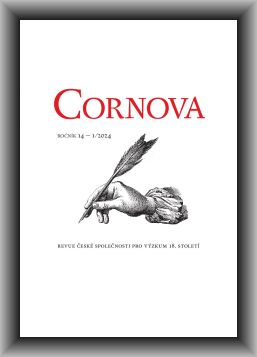An Enlightened Aristocrat
at the Crossroads of Countries and Languages:
Ignác Dominik Chorynský of Ledská (1729–1792)
An Enlightened Aristocrat
at the Crossroads of Countries and Languages:
Ignác Dominik Chorynský of Ledská (1729–1792)
Author(s): Jaroslav StanovskýSubject(s): Cultural history, History of ideas, Local History / Microhistory, Political history, Social history, 18th Century
Published by: AV ČR - Akademie věd České republiky - Ústav pro českou literaturu
Keywords: 18th century; Enlightenment; Silesia; Moravia; Prussia; aristocracy; cultural transfers
Summary/Abstract: This paper focuses on the personality of an important aristocrat from the Age of Enlightenment, IgnácDominik Chorynský, as a person living and acting on the border of countries and languages, creatingan extensive network of social and intellectual contacts around him. The vast personal archive of thisnobleman conserved in Opava still awaits closer examination. Ignác Dominik Chorynský, a member ofan old Moravian family, settled after 1750 in Velké Hoštice under Prussian domination, due to his marriageto Countess Barbora Hodic, while also being active in Opava, on Austrian territory. This paper examinesthe “frontier” position of Ignác Dominik from several aspects. The first is from the political aspect:the count was a subject of the King of Prussia and, at the same time, a regional governor in thePrussian and Austrian parts of Opava, still subordinate to the House of Habsburg. Moreover, his brotherJan Nepomuk fell in the Seven Years’ War against Prussia. Obviously, the position on the border alsoplayed a role in the representation of the count, as evidenced by the “Banquet Hall of Three Lands”,which he had built in Velké Hoštice. In the following portion, this paper presents Ignác Dominik’s widenetwork of contacts: amongst the local nobility in Silesia, amongst actors on the Prussian side (FrederickII, the nobles and intellectuals of Wrocław), and in Moravia (his brothers Matyáš and František Jan,Count Mittrowsky, etc.). This paper then delves into the theme of artistic transfers, as Ignác Dominikcontributed to the cultural development of his region with his activities (building the castle in VelkéHoštice, rebuilding the so-called “Blücher Palace” in Opava, collecting works of art, etc.). Finally, thispaper focuses on the possible role of Silesian and Prussian milieu on Ignác Dominik’s cultural activities.This paper also demonstrates the unique position of the Opava and Hlučín regions after the Warsof Austrian Succession and the imminent role of Ignác Dominik and his close friends in the cultural developmentof the region.
Journal: Cornova
- Issue Year: 14/2024
- Issue No: 1
- Page Range: 65-88
- Page Count: 24
- Language: English

